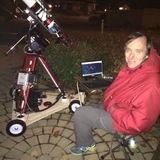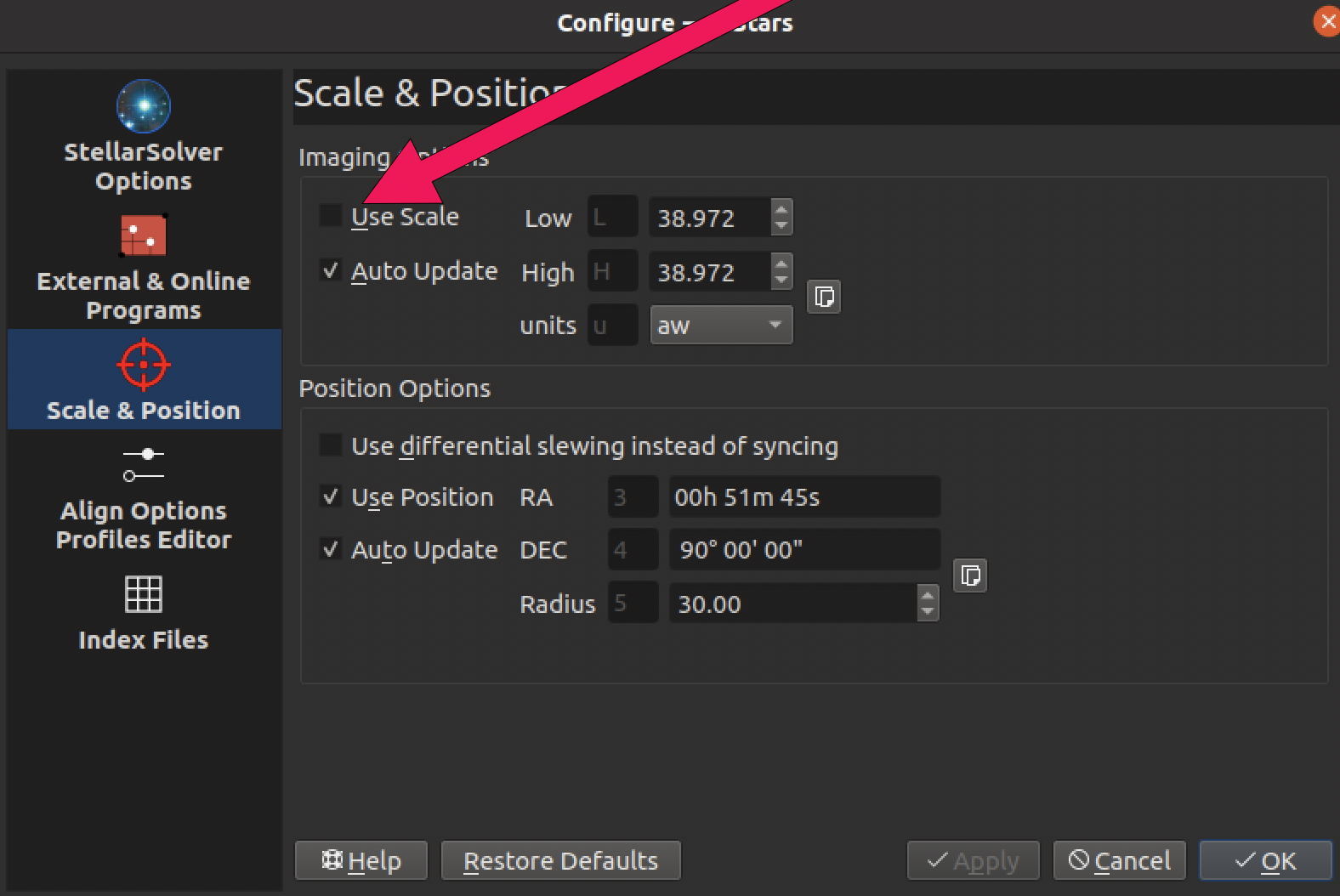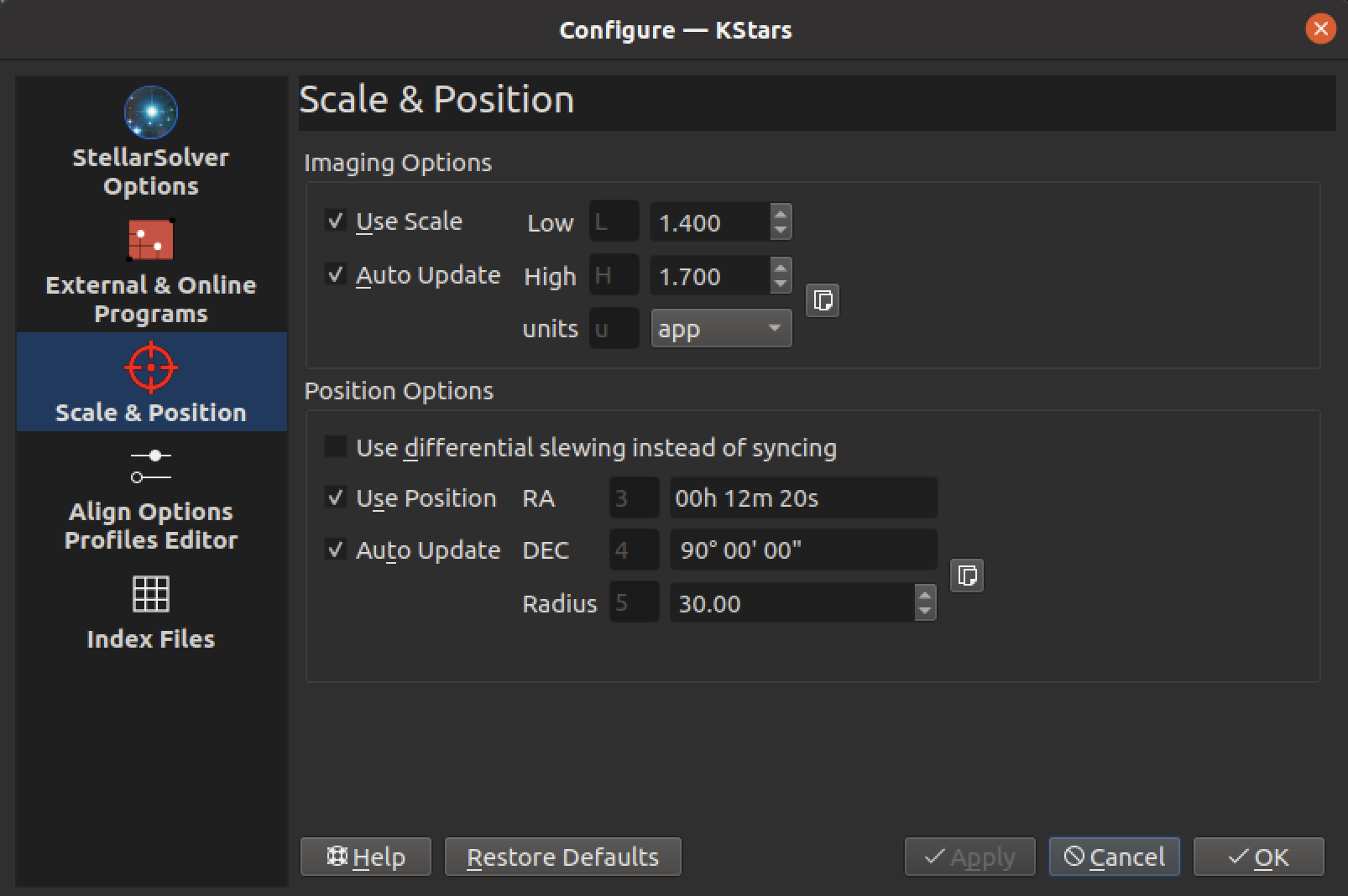INDI Library v2.0.7 is Released (01 Apr 2024)
Bi-monthly release with minor bug fixes and improvements
New Polar Alignment (Plate Solve) not working
Replied by Udo on topic New Polar Alignment (Plate Solve) not working
i have made some screenshots to show my setup. Maybe it helps in reproducing the error. Done on my RPI4 with 2 GB RAM. I have uploaded them as a ZIP-Archive.
I create a new profile containing only the telescope simulator and the ccd simulator. Main telescope set to my 200PDS with 1000 mm focal length (actual 1009 mm resulting from plate solving).
ccd_config.jpg shows the setup of ccd simulator, simulating my Omegon 533 OSC camera.
site.jpg shows the Site Management for the telescope simulator.
plate_solve_config1/2/3/4.jpg show the configuration of the plate solver. This time i tried the "Local Astrometry". I have downloaded ALL index files 2Mass and Tycho2/Gaia - just to be sure nothing is missing....
As the first plate solver run takes more time I pointed the simulator to Polaris and did a simple Plate Solve with Action "Nothing".
The result can be seen in plate_solve_nothing.jpg. Takes little over 60 sec on my Raspi. I used 2x2 Binning, Gain 100 and 6 seconds exposure to show a little more stars in the simulation.
Then i started the Polar Alignment. Direction East, 20°. Plate solver needs little more than 4 seconds now. The Result of the first 3 alignment images is shown in polar_align_1.jpg.
I changed the Refresh rate (=exposure) to 6 sec and choose "Plate Solve". Then i hit the Refresh Button. Result is shown in polar_align_2.jpg - after more than 80 seconds i got multiple timeouts from the plate solver. Then i stopped the process....
I again pointed the simulator to Polaris and tried another solver. This time i switched to the internal solver and cleared the log area.
Again PA with 20° to East. First solve attempt took 49,64s. Mount slews. Second solve took 6.08s. Mount slews. Third solve took 4.72s. All fine. Again hit the Refresh button and the solver timed out. See polar_align_internal.jpg.
Maybe this is due to the modified settings for the plate solver during refresh? This maybe can lead to the first solve attempt taking much longer than the hardcoded 10s?
To avoid local plate solving on my "slow" RPi4 i changed to the online solver but this currently takes more than 10s and therefore is useless for the Refresh phase.
Next try with local ASTAP. First solve attempt with Action "Nothing" took 13.69s. I started Polar Alignment with this Solver. Again the first 3 images are solved without problems in less than 2s. But after Refresh a window showing the ASTAP progress pops up and shows polar_align_astap.jpg. Again: "Refresh solver timed out: 10.0s"
OK - back to the internal solver. Reducing number of stars by changing the exposure time to 2s and binning to 3x3 to hopefully speed up the solver. First "Capture&Solve" with Action "Nothing" took 6.9s. Looks good. See polar_align_internal_1a.jpg
Starting PA with 20° East again. No problems with the first 3 images. Solver solved in 4-5s. Should be fast enough for the Refresh phase. See polar_align_internal_2a.jpg
Hitting "Refresh" and i get "Refresh solver failed: 5.5s". See polar_align_internal_3a.jpg
Conclusion:
If the solver takes more than 10s, the Refresh phase does not work because of the hardcoded 10s limit in the refresh phase.
But: If the solver is "fast enough" i does not work because of unknown reasons... At least for me (and some others?). Less than 6 seconds should be enough - but for some reason the solver did not produce a solution.
I did another test on Merak in Ursa Majoris with the internal solver and 20° West, 2s exposure and 3x3 binning. The result is identical. "Refresh solver failed: 5.1s". And with Polaris with solver profile "Small scale solving". No success. And with "Single Thread Solving". Dito.
Then i reduced the field and search radius of the plate solver (Min Degree Width 0.1, Max Degree Width 1, Search radius 5) and tried again on Solaris with 30° East, 3x3 Binning, 2s exp. Same result: "Refresh solver failed: x.xs".
First step in a possible solution should be to add additional options in the solver settings to make it possible to change the hardcoded 10s interval - as it simply is not enough on slow machines like a RPi4 with small Memory (and not enough for the online solver).
Ciao, Udo
Attachments:
Please Log in or Create an account to join the conversation.
- Matteo Piscitelli
-

- Offline
- Junior Member
-

- Posts: 39
- Thank you received: 9
Replied by Matteo Piscitelli on topic New Polar Alignment (Plate Solve) not working
Attachments:
Please Log in or Create an account to join the conversation.
- Hy Murveit
-

- Away
- Administrator
-

- Posts: 1222
- Thank you received: 565
Replied by Hy Murveit on topic New Polar Alignment (Plate Solve) not working
Would you be willing to Zoom with me, so that I can try and replicate your setup on my Ubuntu VM?
Please PM me on this forum with your contact info. I am available for the next few hours.
Hy
Please Log in or Create an account to join the conversation.
- Hy Murveit
-

- Away
- Administrator
-

- Posts: 1222
- Thank you received: 565
Replied by Hy Murveit on topic New Polar Alignment (Plate Solve) not working
Thanks so much for all the screenshots. I copied all of your settings, and YES! I was just now able to replicate the problem.
Thanks for being so helpful.
I have not yet tried to debug the code, but I did find that when I unchecked "Use Scale", then consistently the issue went away for me.
Perhaps the code is feeding a bad scale to StellarSolver? Don't know yet. Will look into it.
In my experience, StellarSolver solving issues are often related to "Use Position" and "Use Scale".
If you (or others) wanted to try this workaround, simply uncheck that checkbox (see image below).
Hy
Attachments:
Please Log in or Create an account to join the conversation.
- ALESSANDRO PENSATO
-

- Offline
- Elite Member
-

- Posts: 334
- Thank you received: 23
Replied by ALESSANDRO PENSATO on topic New Polar Alignment (Plate Solve) not working
If one or either are disabled which problem they can introduces????
Please Log in or Create an account to join the conversation.
- Hy Murveit
-

- Away
- Administrator
-

- Posts: 1222
- Thank you received: 565
Replied by Hy Murveit on topic New Polar Alignment (Plate Solve) not working
When I go back to "app" (arcseconds-per-pixel), things seem to work for me.
I needed to hand enter the correct arcseconds-per-pixel value, choose "app", and check "use scale".
Then things worked ok. E.g. see the values I used in the image below, which worked for the settings Udo gave me.
Of course, I'll try and find the code issues to fix "aw" as well, but knowing this work-around will allow folks to have a
working setup with the existing release instead of waiting for a new release.
Note, I got the arcseconds-per-pixel values by dividing the field of view (39' = 39*60 = 2340" ) by the number of pixels
(3008/2 = 1504, divided by 2 since we're binning 2x2) so 2340/1504= 1.56 arcseconds/pixel, so I put in a range of 1.4 to 1.7.
(If instead I use aw with a range of 36 to 42, it fails)
Attachments:
Please Log in or Create an account to join the conversation.
- Matteo Piscitelli
-

- Offline
- Junior Member
-

- Posts: 39
- Thank you received: 9
Replied by Matteo Piscitelli on topic New Polar Alignment (Plate Solve) not working
Please Log in or Create an account to join the conversation.
Replied by Udo on topic New Polar Alignment (Plate Solve) not working
great news from you
Of course it would be nice if the problem can be fixed in the code. Maybe the following line of code is the problem:
parameters.search_radius = parameters.search_radius * 2;
This doubles the search radius. Maybe the scale has to be doubled too? Regardless of this: I do not understand why the search radius has to be doubled at all. By default it is quite large - much larger than needed for adjustments done by the mount screws during polar alignment. I think the default search radius is set to 30°, doubled is 60° - this is mechanically not needed. I know no mount that can be adjusted more than a few degrees - and the initial position is already know from the third image captured during PA before the refresh cycles start.
And still an issue if running on a slow cpu and/or with a slow solver: The timeout fixed to 10s. This really should be a tunable setting in the options. Even if more than 10s is quite slow and makes the refresh cycles difficult. Should be to the user if he/she/it has enough patience
But again: Thank you very much for your support. Looks like this very nice feature can be made working for me - and this will help a lot.
Ciao, Udo
Please Log in or Create an account to join the conversation.
- Hy Murveit
-

- Away
- Administrator
-

- Posts: 1222
- Thank you received: 565
Replied by Hy Murveit on topic New Polar Alignment (Plate Solve) not working
I found the problem and the fix is making its way through the system right now. If you're curious, it's a 2-line change here: invent.kde.org/education/kstars/-/merge_requests/734/diffs
Assuming all goes well with the submission, it should be available in the next nightly, but you can easily work-around the issue in the current release by switching to "app" as the "use Scale" option and put in the correct arcseconds-per-pixel value, as I showed above. No need to slow things down by unchecking "use Scale".
If there is a shaky/blurry image in refresh, just let it time out, and wait for the next result. That's the reason for the 10s timeout. As you saw, you should be solving pretty quickly in refresh, which tries to remember the last successful index file. Let me know if this turns out to be a problem.
Hy
Please Log in or Create an account to join the conversation.
Replied by Udo on topic New Polar Alignment (Plate Solve) not working
Maybe i have an idea: There are algorithms in EKOS that can detect if stars are round or elliptical. Maybe the refresh phase can use this to decide if calling the solver makes sense? If the stars are not round (enough) a new image should be captured instead of calling the solver with a potential timeout. Maybe there are other/better ways to check if the image is "worth" calling the solver? Just a suggestion for further improvement in the next releases? If stars are smeared due to movement while adjusting the mount this should be detectable somehow. Maybe even the HFR values or MEAN/MEDIAN or SNR could be used (aka the changes to the previous image) to find out?
Ciao, Udo
Please Log in or Create an account to join the conversation.
- Hy Murveit
-

- Away
- Administrator
-

- Posts: 1222
- Thank you received: 565
Replied by Hy Murveit on topic New Polar Alignment (Plate Solve) not working
Hy
Please Log in or Create an account to join the conversation.
- Gilles Gagnon
-

- Offline
- Elite Member
-

- Posts: 294
- Thank you received: 54
Replied by Gilles Gagnon on topic New Polar Alignment (Plate Solve) not working
Thanks.
William Optics GTF81 on Avalon M-Zero OBS
ZWO ASI1600MM Pro
ZWO ASI290MM (guide)
ODroid N2 running Ubuntu Mate 20.04 LTS
KStars 3.6.0 Beta
Please Log in or Create an account to join the conversation.



